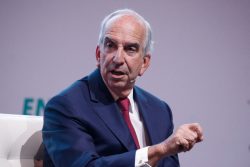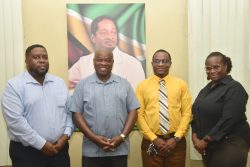As Dave Martins’s popular, patriotic ballad “Not A Blade of Grass” pervaded the airwaves to find acceptance as Guyana’s second national anthem, the sonorous slogan “Every Citizen a Soldier” signalled the establishment of the Guyana People’s Militia in December 1976. Yet, it was quietly disestablished a little over twenty years later in August 1997. What were the reasons for the Militia’s clamorous rise and almost soundless demise?
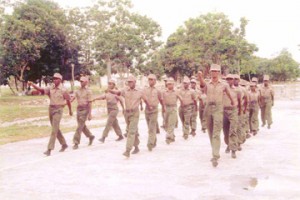
The year 1976 was a time of grave external and internal difficulty for this country. Externally, the administration’s leftward foreign policy lurch, aimed at strengthening relations with China, Cuba, Korea and the Communist bloc, had the effect of alarming, if not alienating, the United States and neighbouring Brazil and Venezuela. In October 1976, Guyana was a victim of the worst international terrorist attack in the western hemisphere when eleven of its citizens were killed in the Cubana aviation atrocity.
Internally, signs that the socialist economic experiment was dragging the country into depression were already evident. The administration complained that the country was the target of a campaign of destabilization and raised fears that both national defence and internal security were under threat.
Origins
The British Guiana Volunteer Force which was established in 1948 had been abolished at the time of independence. But, ten years after independence, the reserve element of the Guyana Defence Force’s 2nd Infantry Battalion which was meant to replace the Volunteer Force had been depleted. Without reserves, the challenges to national defence and security could not be met.
The official response was to reactivate the system of volunteer reserves by establishing the Guyana People’s Militia in December 1976. This decision was prompted by the realisation that a large portion of the civilian population needed to be mobilised, trained and equipped to carry out defence duties while maintaining normal economic production. The Militia’s initial role, therefore, was to provide a framework on which mass preparation for emergencies could be carried out during a period of rising tensions; to support the regular force in all of its functions when called upon to do so; and to provide a reservoir of trained recruits for the regular force.
The Militia constituted a corps of citizens who volunteered to be trained in their spare time so that, in an emergency, they could be called up to perform military service. This was the same principle that had prevailed in the 18th, 19th and 20th centuries up to 1966 – in short, the lineal descendant of the British Guiana Militia and the British Guiana Volunteer Force. It was a belated replenishment of the reserves who were recruited in the immediate post-independence years to reinforce the far-flung frontiers with Venezuela, Brazil and Suriname in the wake of the Ankoko, Rupununi and New River crises.
Administration
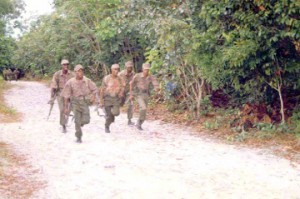
In a departure from normal military organisational practice, an inter-party committee comprising members of the nation’s major political parties represented in the National Assembly was convened to formulate techniques to enhance enrolment, generate enthusiasm and encourage inter-party political consensus for the Militia. The Guyana Agricultural and General Workers’ Union, however, soon complained that control was not sufficiently decentralised or democratic, that the GPM was simply an arm of the defence forces, the distances to be travelled to reach training centres were too great, and the repetitive nature of training in rural areas repelled recruits. As a result, political support for the Militia from certain parties diminished.
The original uniform of the Militia comprised brown caps and badges, beige shirts, and brown trousers but the trousers were later changed to olive green. The emblem comprised a jaguar (the national animal) that also represented land operations; three wavy lines, representing riverine and maritime operations; and a depiction of Mount Roraima representing territorial defence. This was surmounted by a Cacique’s crown, symbolising the authority of the state.
Armed and equipped on a light scale, the Militia was issued with the SKS (Samozariadniya Karabina Simonova) model semi-automatic 7.62mm rifle but these were later replaced by the M 70 model, a copy of the well known Automat-Kalashnikov AK 47 assault rifle. One company was trained and equipped with the towed, quadruple-barrelled, ZPU model 14.5mm anti-aircraft machine gun.
The celebration of ‘Militia day’ on 1st December became a cherished tradition marked by press conferences, open days, exhibitions, religious services, receptions, cultural presentations and parades. In some years, ceremonies were held for the presentation of instruments of commission to officers on that day. The Militia performed ceremonial duties including guards-of-honour and detachments on national parades in all regions and once mounted the guard at State House. It was presented with its Colour by the Prime Minister on 1st December 1979. And a Defence Board decision authorised the award of the Military Efficiency Medal to reservists after 5 years of service including a two-week period of embodiment each year.
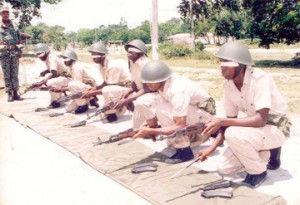
Finance was provided from the Guyana Defence Force’s budgetary allocation. Reservists did not receive a regular salary but were paid a small stipend only when they attended weekly, monthly and annual training sessions and camps.
Organisation
The Defence Act Part I prescribes that the Guyana Defence Force should be divided into two parts – a regular Force and a reserve Force – suggesting a similar, rather than subordinate, status for each. The Militia was that reserve force and was governed specifically by Part IX of the Defence Act. Policy was determined by the Guyana Defence Board which had responsibility for its command, discipline and administration.
On a day-to-day basis, it was commanded by a Commandant who was under the authority of the GDF Chief of Staff. The first Commandant, Colonel Cecil Martindale, had the task of organising the new force on a country-wide basis, unlike previous volunteer forces. In the early days, each of the country’s ten administrative regions provided volunteers of persons between the ages 16 and 60 years and it was the intention that each region eventually would have its own battalion.
The members of the Militia were divided broadly into two components − a permanent staff and a reserve staff. The permanent staff was a group of full-time soldiers who were responsible for conducting training and providing administrative services and logistical support. They also furnished the framework
on which mass mobilisation could take place.
Reservists were part-time soldiers who were divided into two groups − Group A, fit, fully-trained persons under the age of 45 years, and Group B, specialists and experts needed to perform certain essential services on mobilisation. It also contained those persons who, because of age, disability or responsibility, could not undertake rigorous military activities and were liable to be assigned special tasks. Recruitment into the Militia was purely voluntary and, at the outset in 1976, in a surge of enthusiasm and nationalism, thousands of persons from all walks of life in all parts of the country enlisted.
Consolidation
The second Commandant Colonel Carl Morgan assumed command in January 1982 and had the task of consolidating and expanding the force. The basic structure of the permanent staff remained the same. The headquarters which had moved to Diamond on the East Bank in November 1976 was relocated to Main Street in early 1981 and to Brickdam, Georgetown, in 1984. The main training base was developed at Camp Seweyo in the Loo Lands up the Demerara River and regional drill halls and training centres were opened throughout the country to be manned by a cadre of training instructors.
Group A was redesignated the mobile reserve, grouped into battalions drawn from contiguous regions, and tasked with mobile operations in support of the regular force. Group B was further divided into the regional reserve into which were placed women and persons over 40 years of age who were given responsibility for static defence tasks within their regions, and the specialist corps. The regional reserve was organised into companies based on districts of residence; the specialist corps was tasked with reinforcing the corps of the regular force; and reservists of one region were trained on anti-aircraft weapons and restyled No. 23 Air Defence Company.
Within the first decade of its existence by 1986, therefore, the Militia had become a well-organised, well-trained, national military force that was abler and bigger than the Volunteer Force had been in the pre-independence period. By this time, the force had mobilised over 5,000 reservists and was able to deploy about half of that number who could confidently take their place alongside regular soldiers on major military manoeuvres and operations.
Special attention was paid to attracting officer candidates by an aggressive recruiting campaign and by rigorous selection and training during the 1980s. In fact, the number of reserve officers increased by over 400 per cent during the period 1982-1985. As a result, many doctors, engineers, lecturers, managers and teachers responded to calls to join and to participate in the reserve officer training course and the largest group of women officers was commissioned in 1985. Some of them, on being commissioned as officers, elected to attend advanced course available to regular officers.
Born in crisis, the Militia from the outset had to be prepared to participate in defence operations. Training was conducted throughout the 1980s – weekly, at various neighbourhood, district or regional centres on two afternoons; monthly, at weekend camps; and annually, at the central training area at Camp Seweyo. These camps culminated in test exercises that were preparatory to the regular force’s annual field tactical exercise.
Relegation
The economic depression of the 1980s eventually took its toll on the entire military establishment but most severely on the reservists. The strictures of the economic recovery programme of the early 1990s reduced the relative value of financial allocations; money for the payment of stipends and the purchase of food and equipment diminished; recruitment decreased, and membership dwindled.
The Militia was effectively disestablished as an autonomous military formation and re-designated the 2nd Infantry Battalion Group (Reserve) in August 1997 during the presidency of Mr Samuel Hinds. At the inauguration of the new unit at Camp Seweyo, the GDF Chief of Staff justified the change by explaining that the newly-established battalion could be seen as “a solution to the current problems and challenges facing the army [GDF] and it will be a mechanism for countering negative social behaviour threatening the stability of the society.” He added that with the formation of the new reserve battalion, the regular force “would be better geared to carry out its tasks more effectively.” The Chief of Staff continued that the formerly autonomous Militia had been rendered “superfluous and now the State no longer has to provide a separate budget, vehicles and other amenities for the organisation.”
The commanding officer of the newly-established battalion iterated this line arguing that “the GPM as a distinct body was not delivering” and noted that its absorption into the GDF “is a cost-saving move.” The changes, however, seemed to be merely a repetition of the mistake that was made in trying to transform the Volunteer Force into the GDF’s 2nd Battalion over thirty years earlier, a measure which had led to the ruination of the reserves in the first place.
The Militia during its 20-year existence had proven to be a vital component of the defence system that allowed citizens to contribute to national security on a part-time basis without making a full-time commitment to military service. With the loss of autonomy and the depletion in its strength, however, the esprit de corps that was nourished for two decades dissipated.
Many of the Militia’s inherent advantages were lost. Regions without reservists, for example, could no longer assist the regular force to secure porous borders and coastlines or provide organised labour in the event of natural disasters such as floods and other environmental hazards. Most of all, the social capital amassed by the morale and zeal that once motivated ordinary citizens to serve as soldiers and to sacrifice their leisure time to make their country safer seems to have been squandered.






